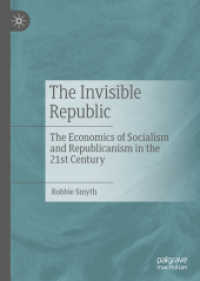Full Description
2003 — Julian Steward Award - Anthropology & Environment Section, American Anthropological Association
2002 — A CHOICE Outstanding Academic Book
How Zapotec agricultural and dietary theories and practices constitute a valid local science.
Zapotec farmers in the northern sierra of Oaxaca, Mexico, are highly successful in providing their families with abundant, nutritious food in an ecologically sustainable fashion, although the premises that guide their agricultural practices would be considered erroneous by the standards of most agronomists and botanists in the United States and Europe. In this book, Roberto GonzÁlez convincingly argues that in fact Zapotec agricultural and dietary theories and practices constitute a valid local science, which has had a reciprocally beneficial relationship with European and United States farming and food systems since the sixteenth century.
GonzÁlez bases his analysis upon direct participant observation in the farms and fields of a Zapotec village. By using the ethnographic fieldwork approach, he is able to describe and analyze the rich meanings that campesino families attach to their crops, lands, and animals. GonzÁlez also reviews the history of maize, sugarcane, and coffee cultivation in the Zapotec region to show how campesino farmers have intelligently and scientifically adapted their farming practices to local conditions over the course of centuries. By setting his ethnographic study of the Talea de Castro community within a historical world systems perspective, he also skillfully weighs the local impact of national and global currents ranging from Spanish colonialism to the 1910 Mexican Revolution to NAFTA. At the same time, he shows how, at the turn of the twenty-first century, the sustainable practices of "traditional" subsistence agriculture are beginning to replace the failed, unsustainable techniques of modern industrial farming in some parts of the United States and Europe.
Contents
Acknowledgments
1. The Conceptual Bases of Zapotec Farming and Foodways
2. Locating Talea: Geography, History, and Cultural Contexts
3. The Craft of the Campesino: Measures, Implements, and Artifacts
4. "Maize Has a Soul": RincÓn Zapotec Notions of Living Matter
5. From Milpa to Tortilla: Growing, Eating, and Exchanging Maize
6. Sweetness and Reciprocity: Sugarcane Work
7. The Invention of "Traditional" Agriculture: The History and Meanings of Coffee
8. Agriculture Unbound: Cultivating the Ground between Science Traditions
Appendix A. Pronunciation of RincÓn Zapotec Terms
Appendix B. Talean Food Plants
Appendix C. Talean Livestock and Game Animals
Appendix D. Selected Average Crop Yields
Appendix E. Recipes
Notes
References
Index








